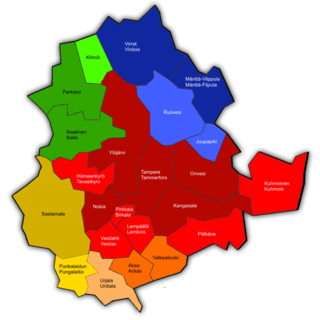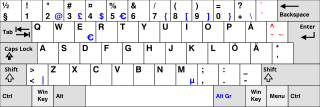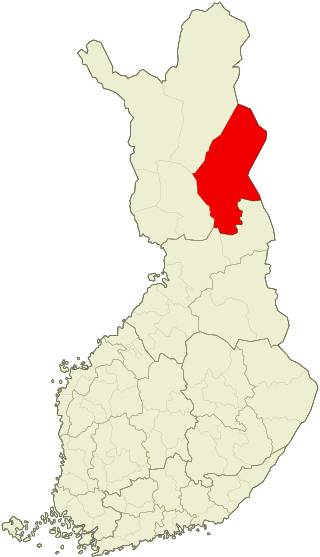| Total population | |
|---|---|
| 11,178 (0.2%) (2022) [1] | |
| Regions with significant populations | |
| Helsinki, Turku, Espoo, Tampere, Vantaa | |
| Languages | |
| Finnish, Persian, Armenian, Azerbaijani, Kurdish, Luri (See languages of Iran) | |
| Religion | |
| 97% Islam 2% Christianity (59% Orthodoxy) [2] 1% others | |
| Related ethnic groups | |
| Norwegian Iranians, Swedish Iranians, Overseas Iranians |
Finnish Iranians or Iranian Finns or Iranians in Finland are Finns of Iranian heritage.
A crime organization tried to sneak illegal Iranian immigrants through the Russian border. According to the Southeast Finland Border Guard District, if they succeeded, they would be smuggling 3-6 Iranians nearly every day. [3] 1979 Iranian Revolution also led to several Iranians moving to Finland.
| № | Municipality | Iranians | % |
|---|---|---|---|
| 1. | Helsinki | 1,169 | 0.26 |
| 2. | Turku | 1020 | 0.65 |
| 3. | Espoo | 834 | 0.47 |
| 4. | Tampere | 704 | 0.30 |
| 5. | Vantaa | 564 | 0.25 |
| 6. | Jyväskylä | 415 | 0.29 |
| 7. | Vaasa | 309 | 0.46 |
| 8. | Oulu | 199 | 0.10 |
| 9. | Lahti | 174 | 0.15 |
| 10. | Lappeenranta | 112 | 0.15 |
55.9% of Finnish Iranians are male and 44.1% are female.
In January 2018, there was a protest held in Central Helsinki, in which 50 Iranians participated in. They wanted Iran to kick out the president Hassan Rouhani and the supreme leader Ali Khamenei. [5]
28% of Iranians are employed, 18% are unemployed and 53% are outside the labour force. Of those inside the labour force, 61% are employed and 39% are unemployed. There are nearly 100 Iranian entrepreneurs. [6] 342 Iranian men are in a registered relationship with a Finnish woman, and 126 Iranian women are in a registered relationship with a Finnish man. [7] [8]

Kauniainen is a town in Finland, located in the southern interior of the country. Kauniainen is situated in the southern part of the Uusimaa region, and it is enclaved by the City of Espoo. The population of Kauniainen is approximately 10,000. It is the 94th most populous municipality in Finland. Kaunianen is part of the Helsinki Metropolitan Area, which has approximately 1.58 million inhabitants.

Rauma is a town in Finland, located on the western coast of the country. Rauma is situated in the Satakunta region, along the Gulf of Bothnia. The population of Rauma is approximately 39,000, while the sub-region has a population of approximately 66,000. It is the 29th most populous municipality in Finland.

Lapland is the largest and northernmost region of Finland. The 21 municipalities in the region cooperate in a Regional Council. Lapland borders the region of North Ostrobothnia in the south. It also borders the Gulf of Bothnia, Norrbotten County in Sweden, Finnmark County and Troms County in Norway, and Murmansk Oblast and the Republic of Karelia in Russia. Topography varies from vast mires and forests of the South to fells in the North. The Arctic Circle crosses Lapland, so polar phenomena such as the midnight sun and polar night can be viewed in Lapland.

Nykarleby is a town in Finland, located on the west coast of the country. Kronoby is situated in Ostrobothnia, along the Gulf of Bothnia. The population of Nykarleby is approximately 8,000, while the sub-region has a population of approximately 50,000. It is the 127th most populous municipality in Finland.

Pirkanmaa, also known as Tampere Region in government documents, is a region of Finland. It borders the regions of Satakunta, South Ostrobothnia, Central Finland, Päijät-Häme, Kanta-Häme and Southwest Finland. Most of the water area in the Kokemäki River watershed is located in the Pirkanmaa region, although Lake Vanajavesi is partly in the Kanta-Häme region. The region got its name from Pirkkala, which in the Middle Ages comprised most of present-day Pirkanmaa. Tampere is the regional center and capital of Pirkanmaa, and at the same time the largest city in the region.

Serbian diaspora refers to Serbian emigrant communities in the diaspora. The existence of a numerous diaspora of Serbian nationals is mainly a consequence of either economic or political reasons.

Hollola is a municipality of Finland, located in the western part of the Päijänne Tavastia region. The municipality is unilingually Finnish and has a population of 22,887 and covers an area of 727.47 square kilometres (280.88 sq mi) of which 68.66 km2 (26.51 sq mi) is water. The population density is 35.13 inhabitants per square kilometre (91.0/sq mi).

The two main official languages of Finland are Finnish and Swedish. There are also several official minority languages: three variants of Sami, as well as Romani, Finnish Sign Language and Karelian.

Eastern Lapland is a subdivision of Finnish Lapland and one of the sub-regions of Finland since 2009.

North Eastern Savonia or Northeastern Savo is a sub-region of Finland. It is an administrative subdivision of the region of North Savo.
Irreligion in Finland: according to Statistics Finland in 2020, 29.4% of the population in Finland were non-religious, or about 1,628,000 people. The Union of Freethinkers of Finland and other organisations have acted as interest organisations, legal protection organisations and cultural organisations for non-religious people. In a 2018 international ISSP survey, 40% of the Finnish population said they did not believe in God, 34% said they believed in God and 26% did not know. Nearly one out of every five people in the country is not a member of a religious organisation, and the number of people with no religious affiliation has doubled in two decades.
Estonians in Finland or Finnish Estonians are people with an ethnic Estonian background residing in Finland. In 2017, there were 52,424 Estonian immigrants in Finland, according to the UN. Estonians are Finland's second largest immigrant group, after Russians.
Norwegians in Finland are immigrants born in Norway, citizens of Norway or speakers of the Norwegian language living in Finland.
Iraqis in Finland are people with Iraqi background residing in Finland. As of 31 December 2022, they numbered 28,022, making them the third largest immigrant group in Finland behind Russians and Estonians.
Dutch people in Finland are immigrants from the Netherlands living in Finland. They numbered around 2,000 in 2017 and live mainly in the cities of Helsinki and Espoo.
Chileans in Finland are people from Chile residing in Finland.

Italian Finns are Finnish-born citizens who are fully or partially of Italian descent, whose ancestors were Italians who emigrated to Finland during the Italian diaspora, or Italian-born people in Finland.

Ano Veli Samuel Turtiainen is a Finnish former powerlifter and politician who served in the Parliament of Finland for the South-Eastern Finland constituency from 2019 to 2023. He is also founder and former leader of the Power Belongs to the People party. He lives in Juva. Turtiainen was elected to the parliament in the 2019 parliamentary election. Turtiainen was expelled from the Finns Party due to him posting a tweet perceived as mocking the murder of George Floyd in February 2021.
The Malayali Diaspora refers to Malayali who live outside their homeland of Indian state of Kerala and Union Territories of Mahé, India and Lakshadweep. They are predominantly found in the Persian Gulf, North America, Europe, Australia, Caribbean, Africa and other regions around the world.

Vesanka is a village and a district of Jyväskylä, Finland. Before 2009, it was one of the villages of Jyväskylän maalaiskunta. It is located in the far western part of Jyväskylä near its borders with Petäjävesi, Muurame and, until 2009, Korpilahti.